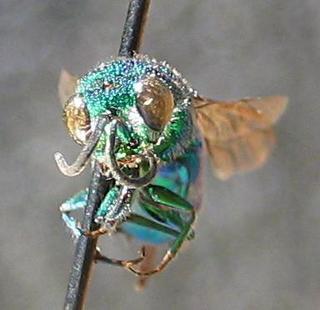
Native Bee Inventory and Monitoring Lab; Photographer: Erika Tucker · 1
Chrysis intricata, face |
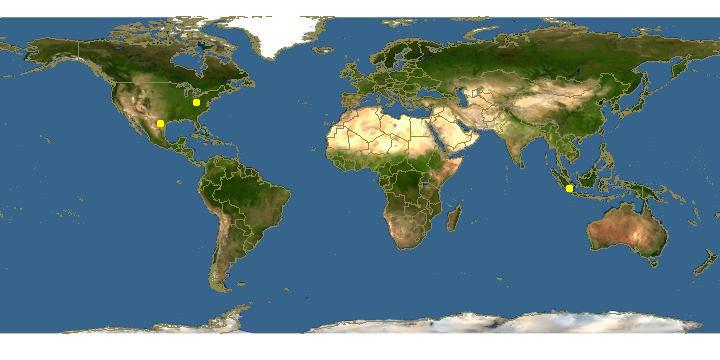
Click on map for details about points.
|
80x5 -
240x3 -
240x4 -
320x1 -
320x2 -
320x3 -
640x1 -
640x2
Set display option above.
Click on
images to enlarge. |
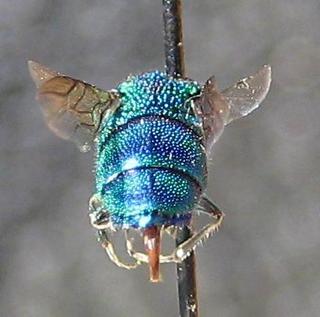
Native Bee Inventory and Monitoring Lab; Photographer: Erika Tucker · 1
Chrysis intricata, tail |
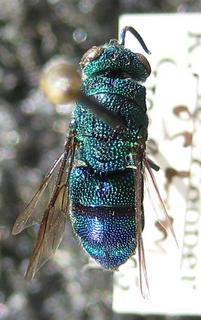
Native Bee Inventory and Monitoring Lab; Photographer: Erika Tucker · 1
Chrysis intricata, top view |
|
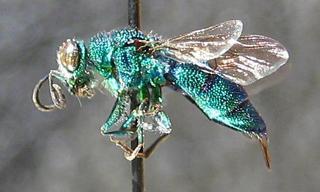
Native Bee Inventory and Monitoring Lab; Photographer: Erika Tucker · 1
Chrysis intricata |
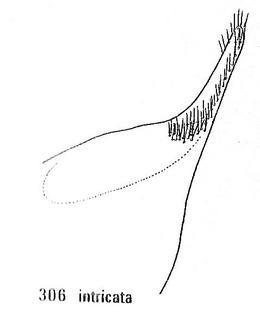
R. M. Bohart and L. S. Kimsey · 1
Chrysis intricata, male paramere |
|
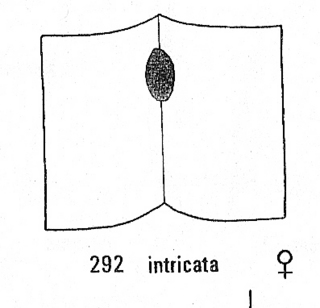
R. M. Bohart and L. S. Kimsey · 1
Chrysis intricata, S2 |
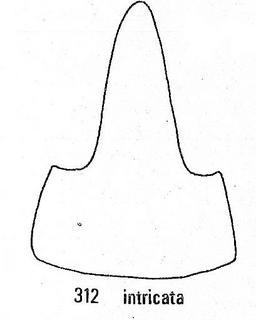
R. M. Bohart and L. S. Kimsey · 1
Chrysis intricata, S8 |
|
Overview |
Taken from:
R. M. Bohart and L. S. Kimsey. 1982. A Synopsis of the Chrysididae in America North of Mexico.
Chrysis intricata Brulle
(Figs. 292, 306, 312)
Chrysis intricata Brulle 1846:25. Syntype female, French Guiana (lost).
Chrysis smidti Dahlbom 1854:317. Holotype female, America meridionali (Lund).
Chrysis cognata Gribodo 1879:328. Holotype female, sed sine dubio America (Brussels).
Chrysis proxima Cameron 1888:465. Holotype female, Panama (BMNH).
Chrysis schulthessi Mocsary 1889:572. Lectotype male (herein designated); Cuernavaca, Mexico (Vienna).
Chrysis aenescens Mocsary 1889:577. Holotype female, Cayenne (Geneva).
Chrysis aperta Buysson 1898 (1897):559. Holotype male, Vera Cruz (Paris).
Discussion: Diagnostic characteristics of intricata are: mesopleuron with two polished knobs, propodeal tooth lobate, T-III area beyond pit row not notched or depressed between medial teeth, teeth with apical tufts of setae, male F-I somewhat less than twice as long as broad and malar space longer than subantennal distance. Although similar to brooksi, intricata can be distinguished by the length of the malar space and the black spots on S-II; in males these spots are contiguous and form a wide indistinct edged band, in females the spots are also contiguous forming a single narrow spot in the middle of the sternum (fig. 292). The male genitalia (figs. 306, 312) are similar to smaragdula, with a long slender apical lobe on the paramere.
Material examined: 16 males, 74 females (including all types except intricata and smidti).
Distribution: This is primarily a neotropical species found as far north as southern Texas and south to Argentina. Records are from TEXAS: Cameron Co. (Brownsville), Hidalgo Co.; MORELOS, VERACRUZ, CHIAPAS, CHIHUAHUA, SINALOA, YUCATAN, SAN LUIS POTOSI, HIDALGO, GUERRERO: Nicaragua; Honduras;
Costa Rica; Panama; Columbia; Ecuador; Venezuela; Trinidad; French Guiana; Brazil: PARA, AMAZONAS, MATO GROSSO, SANTA CATARINA, SAO PAULO, PARAIBA; Bolivia; Uruguay; Paraguay; Argentina. Collection dates are March through August in Texas and Mexico.
Species group of Chrysis smaragdula Fabricius
Diagnosis: Male F-I variable, sometimes shorter than F-II or F-III, sometimes longer than either, 1.0-2.0 times as long as broad, female F-I 2.0-2.5 times as long as broad; subantennal distance 1.0- 2.5 MOD, often shorter than malar space which is 0.5 (tularensis) to 2.5 (praestans) MOD; transverse frontal carina completeto near eye, partial, or absent, not curved in below, usually without backward branches; midocellus surmounted by a thin eyelidlike fold; genal carina separated from eye by at least a narrow pitted area; mesopleuron sometimes dentate, metanotum simple; T-II sometimes with a partial and polished median longitudinal ridge, posterolateral corner 90 degrees or acute; T-III single or double edged, six toothed, lateral edge straight to moderately convex; male genitalia fairly uniform, paramere usually tapering abruptly to slender apical lobe.
Included species: archboldi Kimsey, arizonica Bohart, bequaerti Bohart, brooksi Kimsey, Cresson, inaequidens Dahlbom, intricata Brulle oraria Bohart, praestans Buysson, serrata Taylor, smaragdula Fabricius, tularensis Bohart, and wasbaueri Bohart.
Discussion: Members of this group are medium to large chrysidids with 6 teeth on T-III. A combination of characters distinguish them from our other hexadentate species in the genus: midocellus lidded, frontal carina present, genal carina separated from eye, posterolateral corner of T-II a right angle or acute, no median pit in T-III row, and paramere relatively simple. C. aridula has the posterolateral angle of T-II obtusely rounded, and has a large median pit in the T-III row. C. tenuicornis has the midocellus unlidded, T-II obtuse posterolaterally, and many peculiar features. The smaragdula species group was assigned by Bodenstein (1951:725) to the subgenus Pyria, but it has been amply demonstrated that Pyria, with a greatly reduced F-I in both sexes, as well as a produced or distorted metanotum, is a distinct genus which does not occur in the New World. Bohart (1962) reviewed our hexadentate Chrysis and provided many illustrations.
Based on the three species for which data are available, the smaragdula group attacks Eumenidae: Monobia, Euodynerus, Pachodynerus, Stenodynerus, and Parancistrocerus.
Key to the Chrysis smaragdula group
1. Mesopleuron with two large polished knobs (fig. 294)
..2
Mesopleuron without two large polished knobs
.4
2. IOD about 0.8 OOD, malar space a little less than 1.0 MOD and shorter than subantennal distance
brooksi Kimsey
IOD equal to OOD; malar space 1.0 MOD or more
...3
3. Malar space longer than subantennal distance, S-II spots confluent, forming a narrow medial spot in female and large subrectangular or trilobate spot in male, length 8-11 mm
..intricata Brulle
Malar space shorter than subantennal distance; S-II spots touching, forming a linear black stripe across sternum in both sexes; length 11-15 mm
.smaragdula Fabricius
4. Malar space 1.0 MOD long or shorter, usually a little less and in any case shorter than
subantennal distance
..5
Malar space more than 1.0 MOD long and equal to or longer than subantennal
distance
..8
5. T-III lateral tooth broadly obtuse
..tularensis Bohart
T-III lateral tooth right angled or acute
.6
6. Clypeal margin strongly emarginate (fig. 289), emargination almost 1.0 MOD deep; T-III medial ridge of pit row sunken and more weakly developed than adjacent ridges (fig. 299)
.serrata Taylor
Clypeal margin weakly concave, concavity less than 0. 5 MOD deep, T-III medial ridge not particularly sunken and more strongly developed than adjacent ridges
.7
7. Propodeal tooth weakly lobate beneath, clypeus broadly rounded medially, T-III with edge of submedia.l notch slightly thickened but not bicarinate
.
bequaerti Bohart
Propodeal tooth slightly convex or straight beneath, clypeus subconical medially, T-III with edge of submedial notch thickened and bicarinate (figs. 297, 300)
clara Cresson
8. Malar space at least 2.0 MOD long (fig. 288) subantennal distance 1.5 to 2.0 MOD, F-I usually longer than 2.2 times breadth (fig. 288)
.praestans Buysson
Malar space less than 2.0 MOD long, subantennal distance less than 1.5 MOD, F-I length usually less than 2.2 times breadth
..9
9. Propodeal teeth slightly convex beneath (fig. 290)
.10
Propodeal teeth strongly lobate beneath (fig. 291), lobe about equal to size of midocellus
...11
10. T-III medial and submedial teeth pronglike, much longer than wide at base, medial and submedial notches incised to pit row (fig. 296), pit row overhung by transverse swelling
..arizonica Bohart
T-III medial and submedial teeth subtriangular, about as broad at base as long (or broader), medial and submedial notches not incised to pit row, transverse swelling above pit row weakly developed and not overhanging pits
archboldi Kimsey
11. T-III medial and submedial teeth much longer than broad at base
oraria Bohart
T-III medial and submedial teeth subtriangular, about as long as broad or broader at base
...12
12. T-III edge of submedial notch thickened and bicarinate (fig. 302), transverse swelling preceding pit row large, forming nearly a right angle in lateral view (fig. 302)
...wasbaueri Bohart
T-III edge of submedial notch not thickened or bicarinate, transverse swelling preceding pit row usually small, forming an obtuse angle inlateral view
inaequidens Dahlbom
|
|
| Supported by | |
Updated: 2024-04-25 13:55:57 gmt
|